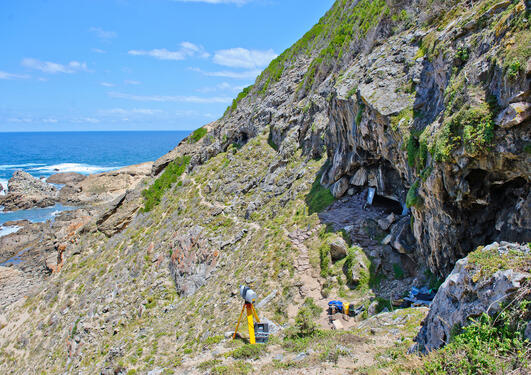Blombos Cave
Blombos Cave is famous for its contributions to our understanding of symbolism and cognition in early modern humans. These finds includes the discovery of the world’s oldest drawing, engravings and shell beads.

Hovedinnhold
Blombos Cave (BBC) is situated in the Blombos Private Nature Reserve on the Southern Cape coast of South Africa. The cave is about 40 m2 (behind drip line), and it was first excavated in 1991.
Symbolic communication
Professor Christopher Henshilwood, today the Director of SapienCE, has led the excavations since the beginning, which has secured consistency in excavation techniques and methods even when new technology has been introduced to the site. This is important because it facilitates comparisons between layers and different excavation phases.
Early modern humans visited Blombos Cave repeatedly between 101 000 to 70 000 years ago, before a sand dune partially sealed the cave entrance. Above the sand dune is material from the Later Stone Age. The discovery of two pieces of ochre with geometric engravings, published in 2002, marked one of the earliest (75 000 years old) indications of symbolic communication among early modern humans. More engraved ochre pieces have been discovered in later excavations, confirming that this type of communication has a long history. In addition, red lines of ochre drawn on a rock discovered at Blombos Cave shows that also painting was practiced at 73 000 years ago.
Early modern lifeways
The processing of ochre is another significant piece of the puzzle of early modern human cognition. A 100 000 year old ochre processing workshop with two toolkits was discovered at Blombos Cave in 2008. The toolkits consists of two abalone shells containing an ochre mixture, possibly used for painting or other purposes.
Blombos Cave also contains information on other parts of early modern human lifeways, including faunal remains that reveal subsistence patterns and hunting techniques.



